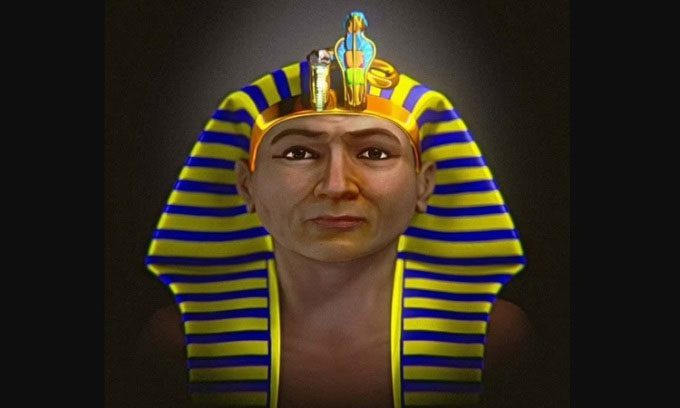Graphic experts recreate the face of Pharaoh Amenhotep I, the founder of the Valley of the Kings and a significant figure in ancient Egyptian history.
Cicero Morares, a Brazilian 3D designer specializing in portrait restoration, created an image of Pharaoh Amenhotep I by combining multiple facial reconstructions derived from various methods, as reported by Sun on September 26. Amenhotep I, the second king of the 18th Dynasty in Egypt, passed away 3,500 years ago at around the age of 35 before being mummified. He was the first pharaoh to be buried in the Valley of the Kings, the final resting place for most pharaohs from the 18th, 19th, and 20th Dynasties. Amenhotep I was worshipped as a god after his death, primarily because he led Egypt into an era of peace and prosperity during his reign.

Portrait of Pharaoh Amenhotep I from the 18th Dynasty of ancient Egypt. (Photo: Cicero Morares)
One method used by Morares involved marking soft tissue thickness points on the pharaoh’s skull, based on CT scan data from a donor. Another technique he applied is known as anatomical deformation, where the digital model of the donor’s head is adjusted until it aligns with the pharaoh’s skull.
Morares carried out the reconstruction using CT scan images of Amenhotep I taken in 2021. The research by radiologist Sahar N. Saleem at Cairo University and Egyptologist Zahi Hawass helped to “unwrap” the pharaoh’s mummy digitally, revealing many details about his appearance, bone structure, and some preserved internal organs, including his heart and brain.
The scans do not reveal the cause of Amenhotep I’s death, but researchers estimate that he died at the age of 35 and had multiple injuries after death, possibly inflicted by grave robbers or due to embalmers re-wrapping his body later, according to archaeologist Michael Habicht from Flinders University in Australia. Amenhotep I stood about 1.7 meters tall, had well-preserved teeth, and curly hair.
By comparing data with all estimates, Morares’ team produced a bust and completed the portrait with historically accurate clothing. Morares noted that the reconstructed face did not match the deity depicted in statues. “Many pharaohs like Amenhotep have a receding chin or a deep bite. This is not reflected in the statues. Overall, the statue of Amenhotep I aligns with the reconstruction regarding the nose, but the forehead between the eyebrows is more delicate and the chin protrudes more,” Morares commented.
Amenhotep I was the son of King Ahmose I, and when his father passed away, Amenhotep I ascended to the throne in Thebes as a child. He ruled during the period of approximately 1525 – 1506 BC. Amenhotep I was deified after his death and became the patron god of the village he founded at Deir el-Medina.



















































